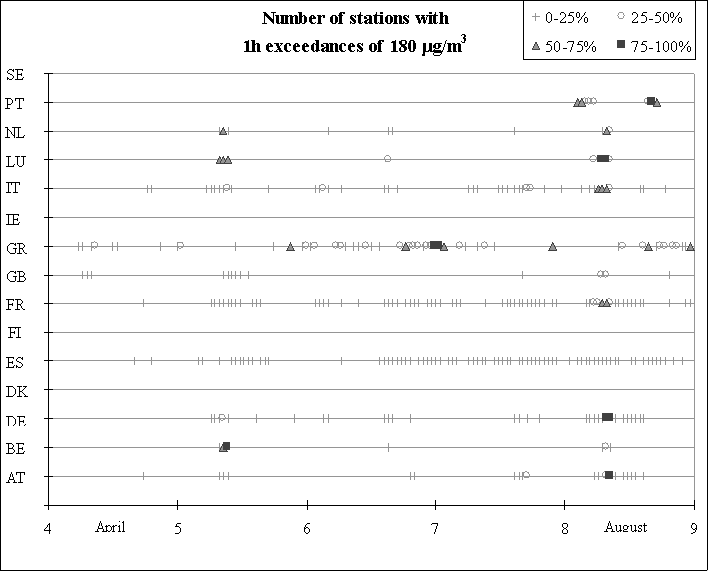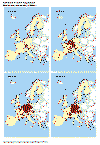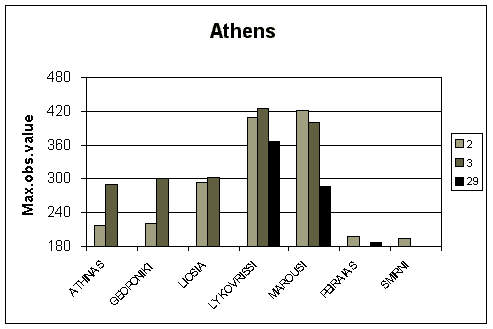4. Main ozone episodes
Ozone formation and destruction is dependent on emissions,
concentrations and ratios of precursors (mainly VOC, NOX, and CO), and on the
amount and intensity of sunlight. Important in this respect is the role of nitrogen oxide
emissions. In urban areas, the ozone concentrations may be lower then the rural
('background') concentrations due to chemical scavenging by local nitrogen oxide emissions
(see for example Figure 3, which shows that the occurrences of exceedances are in general
the highest at rural stations).
Episodes, periods with elevated ozone levels, will mainly occur during
periods of warm sunny weather. In the Mediterranean countries, having prolonged spells of
hot and sunny weather during the summer, ozone can quickly be formed and high levels can
occur on many days and in the vicinity of urban centres. In northern Europe the build up
of ozone is slower due to the more moderate weather conditions. Here, highest levels may
be found downwind of cities. Figure 6 presents a graphical representation of the
percentage of stations in every Member State that reported exceedances of the threshold
value for population information (180 µg/m3 for hourly values) during the 1998
summer season.

Figure 6: Qualitative overview of exceedances of the 180 µg/m3
population information threshold value (1h) during the period April - August 1998. The
symbols represent the percentage of stations which observed at least one exceedance of the
threshold for the information of the public during a particular day.
From Figure 6 it is clear that the number of episodes covering extended
areas of the European territory was limited during April-August 1998. As already mentioned
in Section 3, weather conditions in western and northern Europe were often unfavourable
for the build-up of ozone. On many days cool and relatively clean Atlantic air masses
prevailed in northern and western European countries.
More frequent exceedances were observed in May and August. The most
widespread northern European episode this summer occurred between 9 and 12 August. Map 4
presents an overview of the sites where exceedances were observed on 9, 10, 11 and 12
August 1998. In the text box, the conditions leading to this episode are described in more
detail. In contrast to this, in southern Europe exceedances are observed frequently
throughout the reporting period.
The episode of 9-12 August 1998
On 7 and 8 August, the axis of a West-East oriented high-pressure cell
was located over Central Europe resulting in a light Westerly circulation. Although the
weather could be characterised as warm and sunny in large parts of Europe, the air mass
dominant was relatively clean and exceedances were only reported from a limited number of
sites. On 9 August, the core of the high pressure cell moved to the North Sea, as a result
the circulation became Easterly over large parts of Western and Central Europe.
Exceedances mainly were reported from the Southwestern part of Germany. This synoptical
situation did not change markedly on 10 and 11 August. Very hot and polluted air in the
lower atmosphere became more or less stagnant over the continent. Temperatures on 11
August rose to 37.7 degrees Celcius in Paris, and 41.6 in Braunberg (DE). On 10 August
exceedances were reported from the Western part of Germany, France, Southeastern UK,
Belgium, Luxembourg and the southern part of Germany. On 11 August, the area where
exceedances were observed increased to include large parts of Germany and parts of
Austria. On 12 August, an Atlantic depression started to move in from the west over
Scotland, transporting relatively clean Atlantic air masses over the UK eastwards. This
ended the episode in the Western parts of France, Belgium and the Netherlands. On 13
August, the Atlantic air masses reached most of the EU territory and ended the ozone
episode. |

Map 4: Example of a smog episode: stations which reported an hourly
ozone concentration in excess of 180 µg/m3, 9-12 August 1998 (all station
types).
Figure 7 presents the maximum hourly ozone values recorded in the Athens conurbation
(Greece) in July on days when the threshold for warning of the public (1h >360 µg/m3)
was exceeded, as an example of a local ozone episode in the Mediterranean region. Note
that not all stations presented reported exceedances on every day during this period. More
information on the specific conditions leading to these particular episodes is not yet
available to the authors of this report.

Figure 7: Example of local ozone episodes, Athens July 1998. Maximum observed 1h values
(µg/m3) on stations in the Athens conurbation which observed an exceedance of
at least 180 µg/m3 (1h) on 2, 3 and 29 July.




Document Actions
Share with others